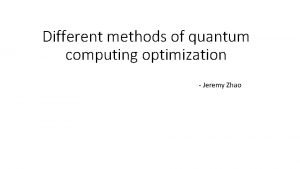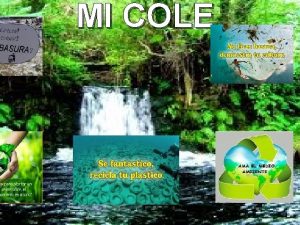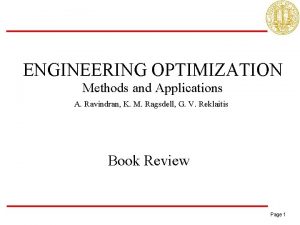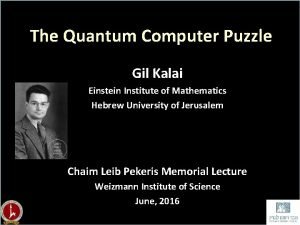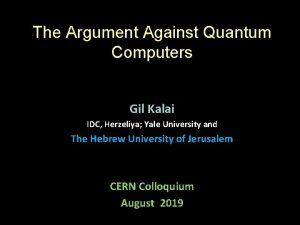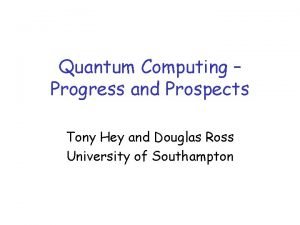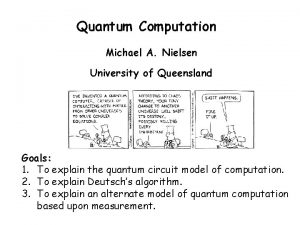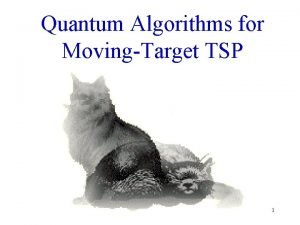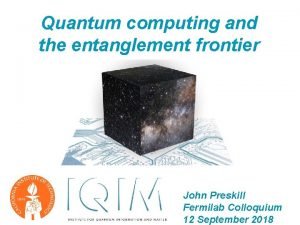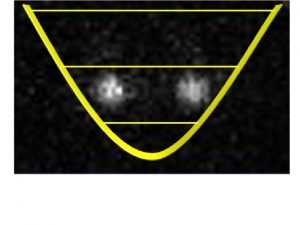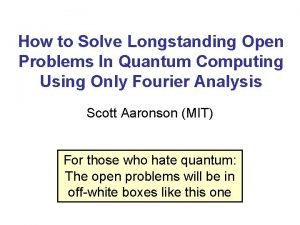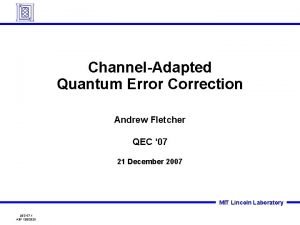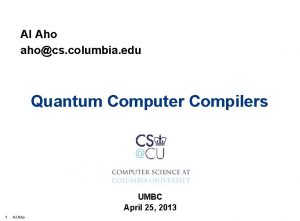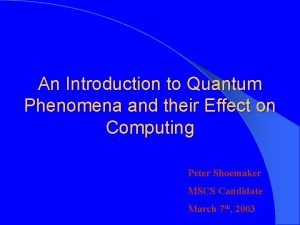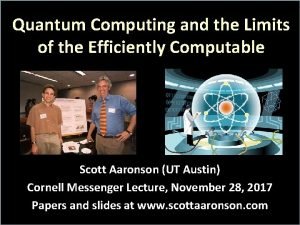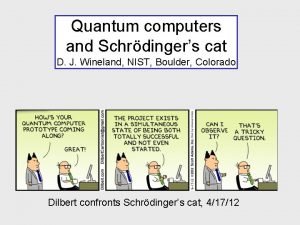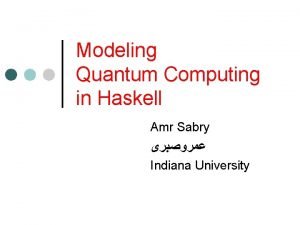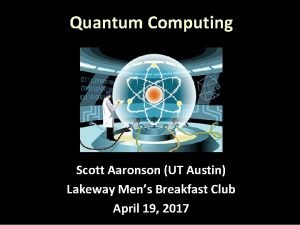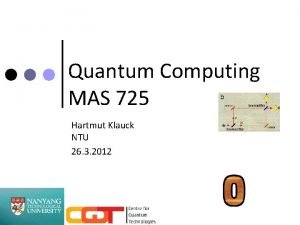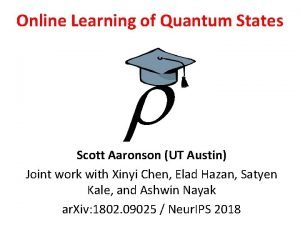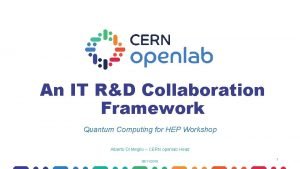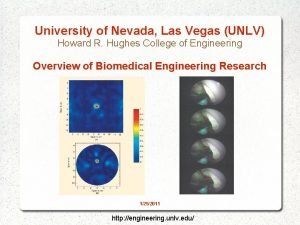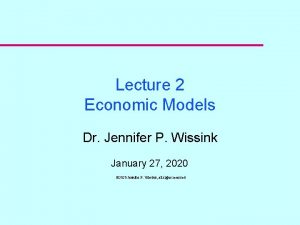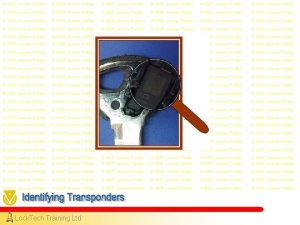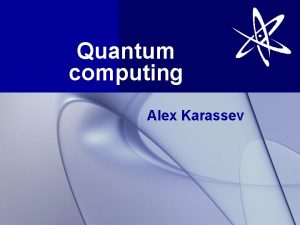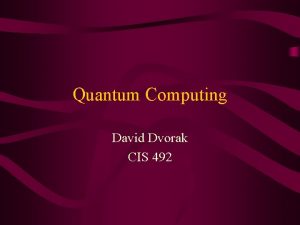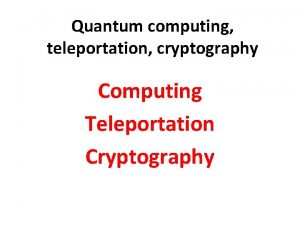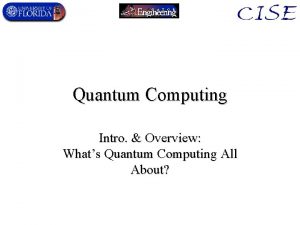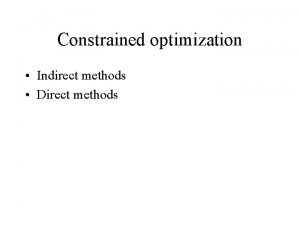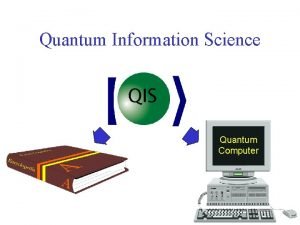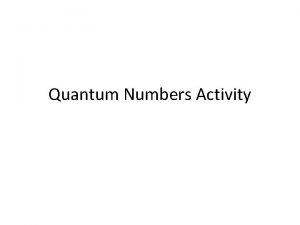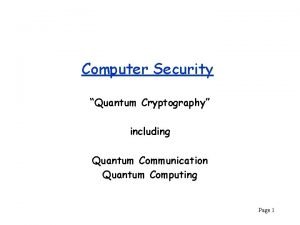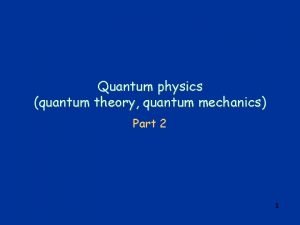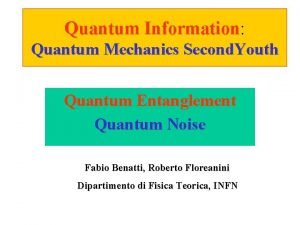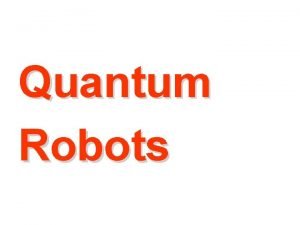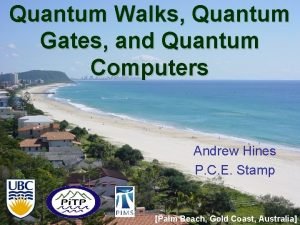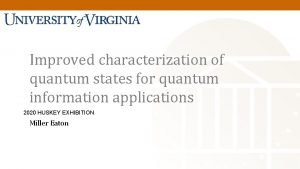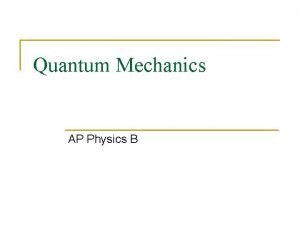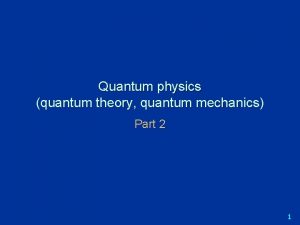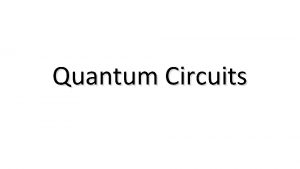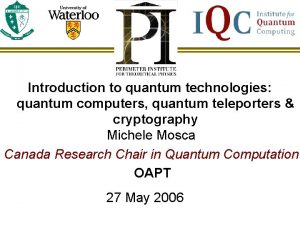Different methods of quantum computing optimization Jeremy Zhao


























- Slides: 26

Different methods of quantum computing optimization - Jeremy Zhao

Introduction In order to understand quantum computing you need to understand how a conventional computer works. In a conventional computer there are transistor which are small switches that can be turn on and off. The computer can read the information as 1, 0 to determine the information. ( The picture on the left is a picture of a quantum gate which is very similar to a transistor)

Moore’s Law Since 1965 there is a special pattern of computing power increase it’s called “Moore's law” , It said that the number of transistors in a dense integrated circuit doubles approximately every 18 month and it was named after the co-founder of intel who observed this pattern in 1965. Because of Moore’s law the computing power was growing rapidly from 1970 s to early 2000 s. Essentially the computing power will nearly double for cpus for every 18 month.

The issue of Moore’s Law is when the gap between the Source and Drain are too small there is a quantum mechanic which will kick in it’s called “tunnelling”. It basically will make electrons jump through the barely no matter what kind of material it’s made out of. Due to this mechanic the traditional computer will reach a bottle neck of computing power very soon. Right now computing chip set manufacture like intel and amd are focus on features and optimization. In order to put more transistor on to a reasonably sized chip they have to make transistor smaller. The easiest way to make that happen is to shorten the gap between the Source and the Drain.

What is a quantum computing? Quantum Computing is a method of computing which use Quantum Mechanics. It use Quantum Bits for unit of information. Due to the nature of Qubits it can solve and calculate certain problems much faster, like weather predication and computer deep learning.

How does a quantum computer works? A few important things to learn about quantum computers are: 1. Qubits 2. Qubit spins 3. Quantum Superposition 4. Quantum Entanglement

Qubit Quantum Bits(Qubits) are the most essential part of the quantum computer, they are what made quantum computer. They are units of information that Quantum Computer use, Just like bits for classic computers. But unlike a transistor used in classic computer, qubits are normally made up with a single nucleus or election.

What makes qubit so special? In quantum computing there is allergy which is “spin” it refers to the position of qubit as we measure it, normally we refer to the low energy state of the qubit as spin down and the high energy state of the qubit as spin up. (EX: a electron in a magnetic field when it’s alien with the field it’s spin down because it has low energy) It can be the equivalent to 0, 1 in classical computer( spin up and down). In order to understand the special property of a qubit we need to understand a few concept, let’s start with spins.

What makes qubit so special? Super position, it’s a very weird concept in quantum mechanic I will try my best to explain. In essence a quantum object can be in multiply state at the same time, but when the object get measured it can only be in one of two basic state- spin up or down.

Quantum Entanglement In essence why quantum computer has the superior performance against a normal computer is when a qubit is in a superposition they can be a probability of two states(spin up, spin down in relative to the measurement) and due to that in a 2 bit quantum entanglement like the diagram showed on the left, need 4 confident information to solve because qubits can be in the probability of any of these four combos. Unlike a normal 2 bit system(11, 00, 10, 01) with a classical 2 bits system we only need to know the value of the first bit and the value of the second bit to know any of the four combos, so it only contains 2 bits of information. But in the 2 bit quantum entangled combo you need 4 confident to determine the information so this system contains 4 bits of information.

• Quantum Entanglement So in a 3 bit system it will contain 8 bits of information, and with N qubits it will contain 2 N bits of information, with the power of exponential if we have 300 bits that’s more than all particles in the universe in equivalent classical bit information. But there is a catch, qubits can only be measured in 2 basic states so the logic of the computer have to be designed in such a way that the end product is not in superposition because it can’t be measured. One cool thing about entanglement is no matter the distance between the qubits they are always entangled, so one qubit can be in outer space when you measure the other qubit which it’s entangled to it will still be in the entangled state with the other one no matter it’s opposite of the same as the other, and the reasoning behind this is still being researched.

Different types of quantum computers There are few different approaches to quantum computing and utilize the potential of the qubits: Quantum Annealing • Universal Quantum Computing: Measurement Base Quantum Computing Adiabatic Quantum Computing Topological Quantum Computing

Quantum Annealing is the only types a quantum computing which is not in experimental phase and it’s one of the relatively easy approach to quantum computing, and it’s the only type of quantum computing which is not under the category of universal quantum computing or gate model quantum computing.

Quantum Annealing, difference between gate model and quantum annealing Quantum Annealing is a process which is unique and it’s a very different approach than gate model quantum computing. In quantum annealing scientist trying to use the nature of physics which everything wants to get to a lower energy state to harness the power of quantum computing, aka they setup the problem and let quantum mechanics do it’s own thing of finding a lower energy state. On the other hand gate model quantum computing is more ambitious their target is to manipulate the process of quantum mechanics there for they can solve higher class problems.

Quantum Annealing, How does it work? Like I mentioned before quantum annealing used the nature characters of quantum physics for qubits to find the lower energy state in order to determine the result. So qubit will start at a superposition, and when annealing finishes they will be in one of 2 basic states(spin up , spin down) because super position can’t be measured.

Quantum Annealing, How does it work? With the energy diagram on the right we can see that when the annealing is finished we will get a diagram which is know as “Double-well potential” that will give us a low energy state. But with all variable being the same the probability of spin up and spin down of the qubits are the same so we can’t solve any problem, there for we have to programme the quantum computer. So in order to control the probability of a qubit falling into one state or another we can apply an external magnetic field to the qubit aka ”bias” to influence the qubit to go to the lower energy valley.

Quantum Annealing, How does it work? Like I mentioned in the introduction of quantum computing the true power of quantum computer shows when you have quantum entanglement because the bits of information is growing exponential. Now we are talking about how to use quantum entanglement in Quantum Annealing, so when qubits are entangled they are concerted as one object but because the number of bit or state is increased exponential so the number of state is 2 N qubits so that’s why it’s faster.

Quantum Annealing, How does it work? So in quantum annealing you will setup a problem for the quantum annealing to solve with the entanglement and the bias to create a energy terrain map which quantum annealing process will be able to find the lowest energy state possible and that will be one of the best solution for your problem and the end result of the solution will be in one of two basic states, it will be measured and transferred to a classical computer and translate to these programme the programmer is using and provide the solution in binary format.

Universal Gate Model Quantum Computing In gate model quantum computing it tries to control the evolution of qubits instead of using the nature of the qubits. But a quantum system is very delicate and hard to work with so the gate model quantum computers are not able to scale up and put in real world use, in theory if they are scaled up they will be way more powerful than a Quantum Annealing computer every will by using algorithms such as Shor's algorithm and Grover's algorithm. But on the other hand D-Wave’s 2000 Q system already has 2000 qubits and it has been in real world use for a few years. And they have a 16 qubit chip since 2007. On the other hand the world’s first Universal Quantum Computer service is just rolling out this year with IBM Q with 5 Qubits, they are getting a 16 qubit one…. . (Gate Model Quantum Computing started development before quantum annealing was devolved. Types of Universal Gate Model Quantum Computing: • Measurement Based Quantum Computing • Adiabatic Quantum Computing • Topological Quantum Computing

Measurement Based Quantum Computing Measurement based quantum computer is a method of quantum computing that first prepares an entangled resource state. then performs single qubit measurements on it. It is "one-way" because the resource state is destroyed by the measurements. ( This is a type of quantum computing that I can’t find much information on and all the information I can find are all from at least 6 years ago, I believe it’s no longer a main stream technology).

Adiabatic quantum computation Adiabatic quantum computing is a type a quantum computing which is closely related to quantum annealing and part of the community believe it can be a sub class of quantum annealing there is a very heated debate around Adiabatic quantum computing and Quantum Annealing. In simply terms Adiabatic Quantum computation is a computational model which is more focus on experimental designs and the optimization of the algorithms.

Topological Quantum Computing Topological Quantum Computer is a very unique type of quantum computer, because it’s completely theoretical and it requires some 2 D quasiparticle which is a particle inside matter which many scientist are not sure that it exists. But Microsoft decide to build their Universal Quantum Computer with this quantum computation model. The main pro of a Topological Quantum Computer is it’s resentence to the outside environment. Because Qubits only need a very small energy to change it’s state so it has to be kept at temperature as close to absolute zero as possible and without any unwanted radiation. But with Topological Quantum Computer we can make Quantum Computer way more robust.

The Future Of Quantum Computing and conclusion The future of quantum computing is bright, But today is not the day that quantum computer will replace the classical computers. With the most “client friendly” option D-Wave computer still needs an extensive support system to keep it running. But in the long run with the superior efficiency and the reduced cost quantum computer can replace big super computers and maybe one day it can replace our personal computer. In my opinion universal quantum computer will be the main stream of quantum computer in the future if scientist can find a method of scaling up it will have way more potential than a Annealing Quantum Computer is capable of. It can solve a class of problem that can’t be solve by classical computer, instead annealing quantum computer can just solve classical computing problem way faster. There are still a lots of challengers to let quantum computer compete with classical computers such as the very low temperature and low radiation environment it have to be in and one day it will face the quantum tunneling issue which classical computer is facing right now but one day it might replace the computer as we know are.

Citation Reference Inc, D. -W. S. (2017, January 11). Welcome to the future. Retrieved January 13, 2017, from http: //www. dwavesys. com/ Qubit (2016). . In Wikipedia. Retrieved from https: //en. wikipedia. org/wiki/Qubit Schrödinger’s cat (2017). . In Wikipedia. Retrieved from https: //en. wikipedia. org/wiki/Schr%C 3%B 6 dinger’s_cat Two-state quantum system (2016). . In Wikipedia. Retrieved from https: //en. wikipedia. org/wiki/Two-state_quantum_system Unitary transformation (2016). . In Wikipedia. Retrieved from https: //en. wikipedia. org/wiki/Unitary_transformation Retrieved January 13, 2017, from https: //en. wikipedia. org/wiki/Bloch_sphere Retrieved January 13, 2017, from https: //en. wikipedia. org/wiki/Quantum_superposition Retrieved January 13, 2017, from https: //en. wikipedia. org/wiki/Quantum_computing Citations, Quotes & Annotations Inc, D. -W. S. (2017, January 11). Welcome to the future. Retrieved January 13, 2017, from http: //www. dwavesys. com/ (Inc, 2017) Qubit (2016). . In Wikipedia. Retrieved from https: //en. wikipedia. org/wiki/Qubit (“Qubit, ” 2016) Schrödinger’s cat (2017). . In Wikipedia. Retrieved from https: //en. wikipedia. org/wiki/Schr%C 3%B 6 dinger’s_cat (“Schrödinger’s cat, ” 2017) Two-state quantum system (2016). . In Wikipedia. Retrieved from https: //en. wikipedia. org/wiki/Two-state_quantum_system (“Two-state quantum system, ” 2016) Unitary transformation (2016). . In Wikipedia. Retrieved from https: //en. wikipedia. org/wiki/Unitary_transformation (“Unitary transformation, ” 2016) Retrieved January 13, 2017, from https: //en. wikipedia. org/wiki/Bloch_sphere ([CSL STYLE ERROR: reference with no printed form. ]) Retrieved January 13, 2017, from https: //en. wikipedia. org/wiki/Quantum_superposition ([CSL STYLE ERROR: reference with no printed form. ]) Retrieved January 13, 2017, from https: //en. wikipedia. org/wiki/Quantum_computing ([CSL STYLE ERROR: reference with no printed form. ])

Bibliography 2 veritasium (2013 a) Quantum cooling to (near) absolute Zero. Available at: https: //www. youtube. com/watch? v=7 j. T 5 rb. E 69 ho (Accessed: 13 January 2017). 2 veritasium (2013 b) Transistors & the end of Moore’s law. Available at: https: //www. youtube. com/watch? v=rt. I 5 w. Ry. Hp. Tg (Accessed: 13 January 2017). Big Think (2011) Michio Kaku: How to program a quantum computer. Available at: https: //www. youtube. com/watch? v=r. UWfod_8 Js. M (Accessed: 13 January 2017). Google (2013) Google and NASA’s quantum artificial intelligence lab. Available at: https: //www. youtube. com/watch? v=CMd. HDHEu. OUE (Accessed: 13 January 2017). Linus. Tech. Tips (2017) Holding a 60 TB SSD. Available at: https: //www. youtube. com/watch? v=Znp. Jmm. C 6 p. Kc (Accessed: 13 January 2017). Techquickie (2014) Supercomputers as fast as possible. Available at: https: //www. youtube. com/watch? v=un. Dql. QA 9 r. U 4 (Accessed: 24 October 2016). Veritasium (2013 a) How does a quantum computer work? Available at: https: //www. youtube. com/watch? v=g_Ia. Vep. NDT 4 (Accessed: 13 January 2017). Veritasium (2013 b) How to make a quantum bit. Available at: https: //www. youtube. com/watch? v=z. Nzz. Ggr 2 mhk (Accessed: 13 January 2017). whentheappledrops (2014) What is quantum mechanical superposition? Available at: https: //www. youtube. com/watch? v=3 E 3 QT-QU 0 bw (Accessed: 13 January 2017). Citations, Quotes & Annotations 2 veritasium (2013 a) Quantum cooling to (near) absolute Zero. Available at: https: //www. youtube. com/watch? v=7 j. T 5 rb. E 69 ho (Accessed: 13 January 2017). (2 veritasium, 2013 a) 2 veritasium (2013 b) Transistors & the end of Moore’s law. Available at: https: //www. youtube. com/watch? v=rt. I 5 w. Ry. Hp. Tg (Accessed: 13 January 2017). (2 veritasium, 2013 b) Big Think (2011) Michio Kaku: How to program a quantum computer. Available at: https: //www. youtube. com/watch? v=r. UWfod_8 Js. M (Accessed: 13 January 2017). (Big Think, 2011) Google (2013) Google and NASA’s quantum artificial intelligence lab. Available at: https: //www. youtube. com/watch? v=CMd. HDHEu. OUE (Accessed: 13 January 2017). (Google, 2013) Linus. Tech. Tips (2017) Holding a 60 TB SSD. Available at: https: //www. youtube. com/watch? v=Znp. Jmm. C 6 p. Kc (Accessed: 13 January 2017). (Linus. Tech. Tips, 2017) Techquickie (2014) Supercomputers as fast as possible. Available at: https: //www. youtube. com/watch? v=un. Dql. QA 9 r. U 4 (Accessed: 24 October 2016). (Techquickie, 2014) Veritasium (2013 a) How does a quantum computer work? Available at: https: //www. youtube. com/watch? v=g_Ia. Vep. NDT 4 (Accessed: 13 January 2017). (Veritasium, 2013 a) Veritasium (2013 b) How to make a quantum bit. Available at: https: //www. youtube. com/watch? v=z. Nzz. Ggr 2 mhk (Accessed: 13 January 2017). (Veritasium, 2013 b) whentheappledrops (2014) What is quantum mechanical superposition? Available at: https: //www. youtube. com/watch? v=3 E 3 QT-QU 0 bw (Accessed: 13 January 2017). (whentheappledrops, 2014)

Reference Adams, A. , Evans, M. , & Zwiebach, B. (2001). Quantum physics I. Retrieved January 13, 2017, from https: //ocw. mit. edu/courses/physics/8 -04 -quantum-physics-i-spring-2013/index. htm# MIT Open. Course. Ware (2014, June 18). 1. Introduction to superposition Retrieved from https: //www. youtube. com/watch? v=l. Z 3 b. PUKo 5 zc Citations, Quotes & Annotations Adams, A. , Evans, M. , & Zwiebach, B. (2001). Quantum physics I. Retrieved January 13, 2017, from https: //ocw. mit. edu/courses/physics/8 -04 -quantum-physics-i-spring-2013/index. htm# (Adams, Evans, & Zwiebach, 2001) MIT Open. Course. Ware (2014, June 18). 1. Introduction to superposition Retrieved from https: //www. youtube. com/watch? v=l. Z 3 b. PUKo 5 zc (MIT Open. Course. Ware, 2014)
 Jeremy zhao
Jeremy zhao Yo quién soy
Yo quién soy Classical mechanics
Classical mechanics Quantum physics vs mechanics
Quantum physics vs mechanics Balaraman ravindran
Balaraman ravindran Gil kalai quantum
Gil kalai quantum Gil kalai quantum computing
Gil kalai quantum computing Quantum computing: progress and prospects
Quantum computing: progress and prospects Michael nielsen quantum
Michael nielsen quantum Tsp quantum computing
Tsp quantum computing Quantum computing
Quantum computing Quantum computing prerequisites
Quantum computing prerequisites Open problems in quantum computing
Open problems in quantum computing Mit quantum computing
Mit quantum computing Mit quantum computing
Mit quantum computing Quantum computing meaning
Quantum computing meaning Quantum computing
Quantum computing Dilbert quantum computing
Dilbert quantum computing Amr sabry
Amr sabry Austin aaronson
Austin aaronson Hartmut klauck
Hartmut klauck Ut austin quantum computing
Ut austin quantum computing Cern openlab quantum computing
Cern openlab quantum computing Conventional computing and intelligent computing
Conventional computing and intelligent computing Direct wax pattern
Direct wax pattern Evangelos yfantis
Evangelos yfantis Jennifer wissink cornell
Jennifer wissink cornell
